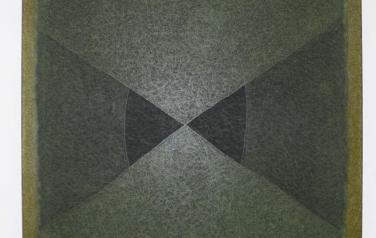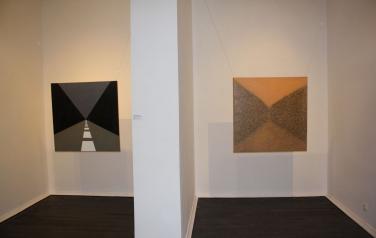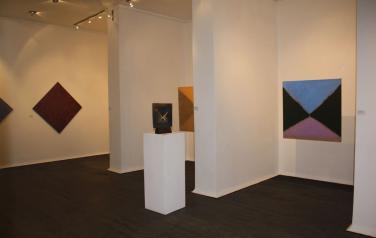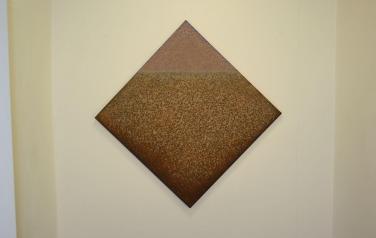“The road or path?”
In a catalogue article, as a rule, it is customary for the artist’s new work to be compared with the previous phase of his creativity, in order to show the sequence and pattern of the artist’s self-realisation. In order to make it clear that the artist has not swerved off onto the dirt track of the outsider and has not moved onto the wide and comfortable, but at the same time, dangerous highway of the mainstream, and that he has not been in the roadside ditch of creativity.
Boris Markovnikov has not always adhered to and complied with the road regulations, if by such one means that system of contemporary art which has been established by a whole corpus of articles of authoritative figures, serious publications and catalogues. So, in his case, one can talk about a sequence of formal decisions only under certain conditions. What had once been done in the world of contemporary art, Markovnikov did somewhat later, but, some things he did simultaneously with what was happening “there”. It happened that it was at the same time, but not as “they” did it. For example, in the first half of the 1990s, he and the group “Polygon”, in which, incidentally, he was the protagonist, engaged in a kind of vivisection of the foundations and means of easel painting. These tests of the strength of the materials, were, to some extent, reminiscent of similar experiments done by the French group “Support-Surface”, which had occurred much earlier. But if the French analytical approach had structuralism as its theoretical base, then the Muscovites had no such foundation. For the latter analysis was replaced by the drive of innovations which had then come down to us, such as German neo-expressionism or the Italian Trans-avantgarde. For this reason, Western art-surgery was transformed by the Muscovites into almost an artistic sacrifice. Who knows why we give rise to such metamorphoses? Is it that we have such a cultural climate and landscape that force everything brought in to evolve, mutate and adapt. Maybe, generally, in our conditions there are no direct paths in contemporary art.
Boris Markovnikov is now on “The Road”. Not only in the sense that he has been painting a series with such a name, but that he instinctively went onto such a highway on which he turned out to be the only one, moreover, there is no-one to ask for directions: there are no signs, no vehicles behind him, no oncoming traffic. This is quite a typical Russian road, familiar to many, leading no one knows where. On the right and left – there are dark woods, a little light at the top – the sky, a little light at the bottom – the highway, and the entire wedge of the perspective – leading nowhere. It is dusk. This is only a brief and consequently superficial description of the artist’s paintings, following which explanations are necessary.
Thus, Boris Markovnikov’s new works can be looked at as ordinary road or travel scenes. Though, if looking from a specific perspective, they could be considered as a new version of minimalism or as somewhat late “Zero”, because they are so geometrically simplified. They can even be, if one particularly wishes, ascribed to the “flickering views” type, as Oleg Vasiliev, an American critic, said.
However, it seems that the stimuli here are quite different. In fact, let’s say that the real motivation is: an artist is riding to his distant “dacha”, in some remote place (say, in the Kaluga Region), and along the way he notices some interesting views. But the fact is that these views are by no means those usually considered interesting, they are banal, constantly repeating. Remember such a road at that time of day which is called “between a wolf and a dog”, that is, at twilight. One view differs little from another, and even the rumble of the engine would lull one into a dangerous slumber. The only thing that keeps the driver/artist awake is that vigilant and warning inner voice. It is the latter that calls out the titles of the works: “The City is Nearby”, “Strange Place”, “Turn Right!”…
In the series “The Road” a strange silence is heard, if one may say so. Though, seemingly, nothing special is happening, there is an alert expectation of something important, which is just about to happen, simply must happen. It should be said that this is rather a dangerous state, when this very expectation may turn into a catastrophe. Or may…
One way or another, Markovnikov, as a sort of guard, is peering into this endless monotony so hard that his eyes smart, and is waiting for something. Perhaps for just the same thing as the hero in Dino Buzzati’s “The Tartar Steppe”, who was waiting at a godforsaken frontier outpost for something or someone to finally come out of the desert valley, out of the perspective of the converging wedge of mountains. With the help of plasticity itself, Markovnikov seeks to convey such expectation and even impatience. However, the plasticity, in his case, is of a special kind. Most likely it is its reverse side, because it is plasticity, as it were, turned inside out: it asserts itself, paradoxically, by denying itself.
Grattage – is a scratching technique, whose origins can be traced back to antiquity. In Markovnikov’s work grattage, or scratching the canvas (for some reason, he does not accept the French term) is a kind of labour ex voto (“in fulfilment of a vow”), heavy physical work which he voluntarily takes upon himself. Moreover, coupled almost with self-humiliation: for the incising of the scratches on colour surfaces, which are practically ready and finished and aligned according to hue, leads to the destruction of the picture, doesn’t it? However, the artist does it consciously. But not only in order to belittle himself as an artist (there is no question of playing the fool here), but in order to reveal a different plasticity. Grattage in Markovnikov’s work is a paradoxical painting system in which the counter-strokes (i.e. scratches) are not made with a brush, but using a chisel or knife. This is the removing or extraction of pigment, that is, a technique of cutting out or subtracting from the paint layer. But, at the same time, paradoxically, the same effect arises as in tonal painting, as in the works of the Old Masters who patiently, brushstroke after brushstroke, superimposed paint layers. That is, the same feeling of the vibration of the painting’s surface is created. In this way the notion of “living painting”, in its original sense, (which is not contained in the terms: painting, peinture, pittura) is resurrected here by apophatic (that is, by negative) proof. And the idle maxim that painting is dead is challenged quite convincingly.
Mikhail Bode









